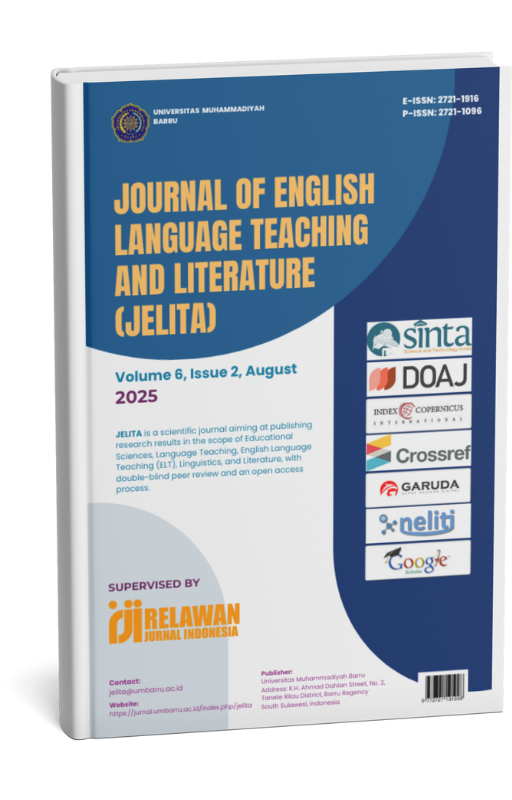Designing Electronic Comics to Develop Students' Reading Comprehension of Narrative Text
Design and Development Research to The Eleventh Grade of SMA Islam Bawari Pontianak in Academic Year 2024/2025
Abstract
This study aims to investigate the design of Electronic Comics to enhance students' reading comprehension of Narrative Text, and to identify the strengths and weaknesses of Electronic Comics in this regard. This study uses the Design and Development Research (DDR) method, which involves three main phases: analysis, design, development, and evaluation. Data were collected through observation, interviews, and comic trials. The research participants were three English teachers, one media expert, and eleventh-grade MIA students. The findings obtained in designing were: In the analysis stage, researchers conducted observations and interviews to understand students' constraints and preferences for learning media. In the design and development stage, two narrative texts were transformed into electronic comics and validated by experts. Validation results showed that the first Electronic comic achieved a score of 83%, and the second achieved a score of 96%. After that, an Electronic comic trial was conducted in the eleventh grade of MIA for the evaluation section to find strengths and weaknesses. The strengths of electronic comics include visual appeal that increases students' interest in reading and the ability to present information interactively and engagingly. However, the weakness is the limited access to technology for some students, which can affect the effectiveness of its use.
Downloads
References
Abbott, H. P. (2020). The Cambridge Introduction to Narrative. Cambridge: Cambridge University Press.p.13
Adiyan, F. (2022). Improving Students' Reading Comprehension of Narrative Text Using Folklore at SMK Negeri 9 Kabupaten Tangerang (A Classroom Action Research). Jurnal Pendidikan dan Science, 2(2). Retrieved from https://jupisi.untara.ac.id/index.php/jupisi/article/view/30
Aggleton, J. (2019). Defining Digital Comics: a British Library Perspective. Journal of Graphic Novels and Comics, 10(4), 393–409. https://doi.org/10.1080/21504857.2018.1503189
Applebee, L. (2014).Understanding Reading Comprehension: Processes and Practices.Sage Publication
Brante, E. W., & Holmqvist, M. (2017). Reading from multimedia materials: benefits of non-congruent pictures on reading comprehension for dyslexic readers. TOEJET: The Turkish Online Journal of Education Technology, 16(1), 101-114.
Dewi Nopita. (2022). Designing an E-comic for English Reading Material for Grade Eight in Tanjungpinang. Journal of Language, Literature, and English Teaching. https://doi.org/10.31629/juliet.v3i2.4862
Dudeney, G., & Hockly, N. (2016). Literacies, technology and language teaching. In F. Farr & L. Murray (Eds.), The Routledge handbook of language learning and technology (pp. 115–126). Routledge.
Frechette & Williams.(2016). Media Education for the Digital Generation.Roudletge Taylor & Francis Group
Halliday, M. A. K. (2020). Written language, standard language, global language. In C.L. Nelson, Z. G. Proshina, & D. R. Davis (Eds.), The handbook of World Englishes (2nd Edition), 331–348. UK: John Wiley & Sons Inc.
Harsuni Winarti. (2018). English Digital Comic for The Students of Senior High School in Banten. Annual International Seminar on English Language Teaching.DOI: http://dx.doi.org/10.30870/aiselt.v2i2.10951
Hobri, Murtikusuma, R. P., & Hermawan, L. I. (2019). Development of an E-Comic Using Pixton and Kelase Web on the Linear Program of Two Variables Assisted by GeoGebra. Journal of Physics: Conference Series, 1265, 012010. https://doi.org/10.1088/1742-6596/1265/1/012010.
Jen. (2019). Defining digital comics: a British Library perspective. Journal of Graphic Novels and Comics, 10(4) pp. 393–409.
Lahagu, Y., Pangaribuan, J. J., & Prayuda, M. S. (2020). Improving students' reading comprehension on narrative texts through the Experience Text Relationship (ETR) method at SMA Swasta Palapa Medan in the academic year of 2020/2021. Kairos ELT Journal, 4(2), 66-79. http://ejournal.ust.ac.id/index.php/KAIROS/article/view/1137.
Maity, J. (2022. Comics in Digital Forms: An Overview and Growth of Digital Comics in the Present Era. Contemporary Literary Review India, Vol. 9, No. 1, pp. 86-98, https://literaryjournal.in/index.php/clri/article/view/1039.
McCloud, S. (2008). Understanding comics: the invisible art. First HarperPerennial edition. New York, HarperPerennial.
Muliani, S., Norahmi, M., Asi, N. (2018). The analysis of Difficulties in Writing Text. LET: Linguistic, literature, and language teaching. https://dx.doi.org/10.18592/let.v9i2.3312
Nurdiana & Amelia, R. (2017). Interpretive Reading. Pekanbaru: Kreasi
Raharja, H E. (2023).The Effect of Digital Comics on Students' Reading Comprehension of Vocational School Students.RETAIN (Research on English Language Teaching in Indonesia) (e-Journal).Volume 11, pg 73-77
Richey, R., & Klein, J. (2007). Design and development research: Methods, strategies and issues. Mahwah, New Jersey: Lawrence Erlbaum Associates, Publishers.
Rose, H. & Galloway, N. (2019). Global Englishes for Language Teaching. Cambridge: Cambridge University Press.
Saputra, V. H., & Pasha, D. (2021). Comics as a Learning Medium During the COVID-19 Pandemic. Proceeding International Conference on Science and Engineering, 4, 330–334.
Woolley, D. G. (2011). Reading comprehension: Assisting children with learning difficulties. Springer Netherlands. p.15
Copyright (c) 2025 Alifa Raisha Shafiqa, Ikhsanudin Ikhsanudin, Sumarni Sumarni

This work is licensed under a Creative Commons Attribution-ShareAlike 4.0 International License.







